How To Design Emails That Convert (13 Tips + Examples)

Email is still one of the most effective digital marketing channels out there.
It’s a powerful tool for supporting your blog and the rest of your business, but only if you use it right.
If you don’t – your efforts could be completely wasted.
So, let’s make sure that doesn’t happen.
In this post, you’ll learn how to design emails that convert.
It’s easier than you might think. And by the end of this post, you’ll know exactly how to take your email marketing strategy to the next level.
1. Choose the right email marketing software
Before you get started, you’re going to need email marketing software so you can design & send emails.
If you have this and are already sending email campaigns, you may want to skip to the next section.
But if you haven’t – this is the first step to designing emails that convert.
Now, there are plenty of tools on the market you could use but there are two main things you need:
- High email deliverability rates.
- The ability to design emails that convert.
When it comes to getting your emails delivered, there are various things you can do to improve this such as using email verification tools, verifying your sender domain with DKIM & SPF DNS records, etc.
But – the email marketing tool you choose will have a significant impact on delivery rates.
Then there’s the ability to design emails that convert. Most tools will offer a large selection of templates and while some may be a good fit for specific purposes – as soon as you want to change them, that’s when you run into problems.
This is why it’s a good idea to go for a tool that includes a drag & drop email newsletter builder.
One of our favorite tools for this is MailerLite – they have extremely good delivery rates, all the important features you’ll need, and a generous free plan.
Here’s a quick look at their email builder:
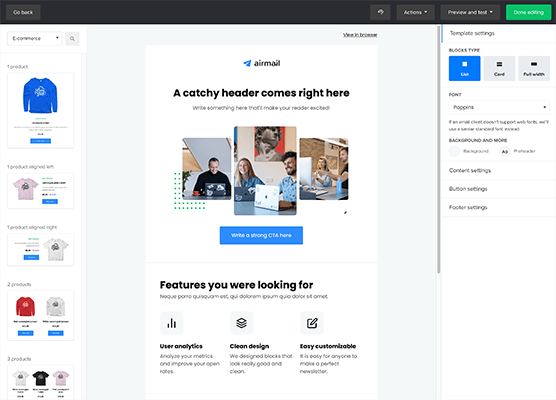
The builder uses pre-made blocks so you can build emails in a way that makes sense for your brand. You can add content blocks, image blocks, various types of CTA’s, etc. There’s also specific blocks for promoting ecommerce products, and more.
Sign up for your free MailerLite account.
Now, let’s take a look at how to design emails that convert.
2. Understand your target audience
As with all things digital marketing, you set yourself up for the greatest chance of success when you know your audience inside and out.
The ability to connect with your audience and convert them into customers with email will be greatly affected by your understanding of their needs, pain points, interests, personalities etc.
Greater connection means higher open rates, engagement and trust which all lead to more conversions.
If you have a blog, then you’ve probably already carried out in-depth customer research and created your audience or buyer personas.
If you haven’t, go do this now. If you have, it’s always good to revisit and refresh your knowledge. If you aren’t sure who your target audience are, then you need to go back a few more steps.
Pro Tip: If you have a longstanding blog, then you will already have a huge amount of information at your fingertips about your target audience. Metrics such as page views, social shares, and comments on your posts can tell you a lot about your readers that can help you with email design.
3. Don’t skip strategy
Once you know your target audience inside and out, you can plan your email marketing strategy with focus for maximum conversion.
One of the secrets to high-conversion email design is building a relationship with your list over time. A well-thought out email sequence is much more likely to end in conversion than a one-off, lukewarm email. One-off emails have their place too, but they are more likely to be successful when part of a wider marketing strategy.
Email marketing strategy is beyond the scope of this post, but here are the main takeaways to consider:
- Set clear goals: SMART goals are an efficient way of doing this.
- Choose the right campaign type to match your goals.
- Segment your audience. (see the next point!)
- Use analytics and metrics to inform, track and optimize your strategy.
4. Segment your email list
Segmenting involves splitting your email list into smaller groups or segments based on certain characteristics so that you can focus your email campaigns and messages more effectively.
Segmenting your list helps to boost conversion rates as recipients are more likely to find your content relevant and useful, increasing open rate, engagement and, therefore, conversion.
Here’s an example:
If you are a music tuition company for Rock and Pop producers, you can segment your list into fans of these two genres. When you have a promotion on a Rock related course you can schedule it to send to people in the Rock list only.
This helps to increase your open, engagement and conversion rates because Rock is their jam! It also means less unsubscribes from people that aren’t interested in Rock, maintaining the integrity of your list for future conversions.
Attributes that you can segment by include:
- Demographics: such as age, income, job role.
- Interests.
- Behavior: What did the reader do to get sent an email? Did they abandon a cart? Or download a lead magnet, etc.
- Lead magnet type: Which lead magnet did they download before joining your list?
- Budget.
- Customer life-span.
- Location.
Everybody wins with segmenting, it helps to cut through the chatter in inboxes, your readers get relevant and actionable content, it increases ROI and conversion. Segmenting can increase revenue by as much as 760%!
You can segment at the start of your campaigns further along the funnel too.
Here is an excellent example of segmenting your list early on by email marketing educator Max van Collenburg:
Which will allow him to deliver more targeted email marketing content based on what his audience what’s to sell:
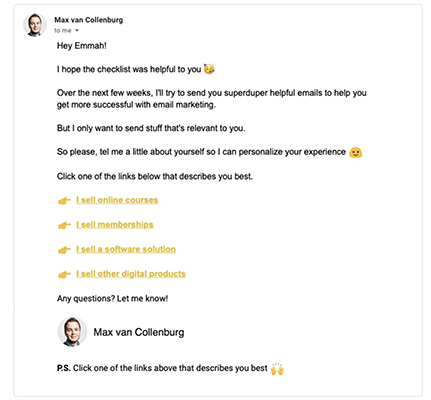
Don’t worry if this all sounds complicated, any of the email marketing platforms we mention in this article will have simple to use segmentation tools.
Pro Tip: Look at the different topic areas that your blog posts fall into. Could you use these as a starting point for your segmentation strategy and segmented campaigns?
5. Simple design characteristics that will improve conversions
You don’t have to add “incredible graphic designer” to your ever-growing list of skills to create emails that convert. Any of the email marketing platforms we mention in this article have tried and tested email templates you can use and edit to taste, or you can easily build effective emails from scratch using them.
Here are some features that will help and those that will hinder conversion when it comes to the visual element of your email design:
White space is your friend
Trying to fit too much into your designs looks messy, confusing and can detract from getting readers to click your CTA and convert. It also looks unprofessional, which can reduce trust and the chance of conversion.
Take a look at the use of white space in this email from music software designer Izotope:
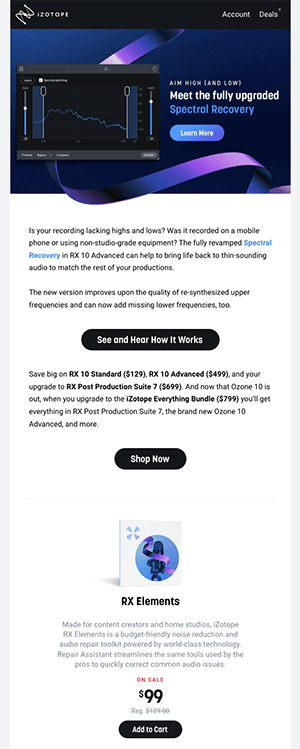
Use your company’s branding
It seems obvious, but it’s easy to forget, carry across company branding to your emails. Use brand colors, your chosen font, logo, and brand elements where appropriate.
This gives your emails a professional finish, which builds trust in your brand, and more trust = higher conversion rates.
Use impressive images
High-quality images also show that you are professional and add to the impact and engagement of your emails. If you use stock photos, make sure they are epic stock photos and add your own stamp where you can.
Certain image characteristics affect email deliverability and, in turn, conversion. An image to text ratio that is too high can get your emails stuck in spam filters. Different spam filters have different rules on the ratio.
Many sources recommend a 60:40 text to image ratio, but others, air on the side of caution with 80:20.
Related Reading: 17 Ways To Avoid Email Spam Filters.
Should I use HTML or plain text emails?
It can be tempting to send nothing but beautiful images and standout CTA’s all of the time. Such as this one from sample pack company Loopmasters:
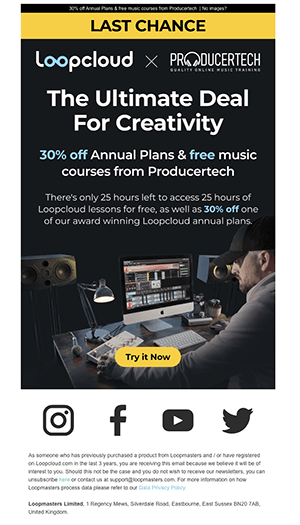
However, HTML emails are not always needed or the best option.
Sometimes short, sweet and simple plain-text emails are a better choice. Such as this one from music production coach Mike Monday:

The merits of each type are outside the scope of this blog post, but take a look at this post to get a primer on HTML vs plain text emails.
6. Write a scroll-stopping email subject line
100% of emails that aren’t opened, don’t convert.
Want to increase conversions? Learn to write incredible subject lines that make sure your email gets opened.
The average email open rate across all industries is 17.57%. So, there is definitely room for improvement here.
The subject line, pre-header and sender are the only things recipients have to go on when deciding whether to open your email, let alone click a call-to-action, so make it count.
These tips will help you write subject lines that convert:
Create a sense of urgency
Using a time-limit in your subject line AND the main body of your emails is one of the most effective ways to drive conversions.
Personalize
Using a recipient’s name and details that speak specifically to them (with the help of segmenting mentioned earlier) can get a reader’s attention and pique their interest enough to get them to open a message.
Bjorgvin Benediktsson of audio-issues.com, a resource and education website to help musicians turn into professional producers, connects with his audience in one his emails by providing a solution for a common problem that his audience face, overwhelm:

Add an emoji
The open rate of emails that feature emojis in the subject line is over 50% higher than those that don’t, with the clock and timer currently being the most effective,
Just Eat got it right with this chef emoji:

The resend trick
Use this one with caution as using it too much can lead to unsubscribes. Sometimes a subject line just doesn’t resonate with a reader, even though you know the email is jam-packed with content you know they are going to love.
One hack to increase your open and conversion rate is to reschedule emails that don’t have a high open rate to resend to the people in your list that didn’t open them the first time, but this time with a different subject line, giving you a second chance at getting your key message read.
Keep it short and sweet
A short subject line has been shown to perform much better than a long one.
Here’s an example from Your Creative Aura. Nicola Bleu’s subject line “Week #: Songwriting Exercise” is short and to the point, and they convert at over 41%:
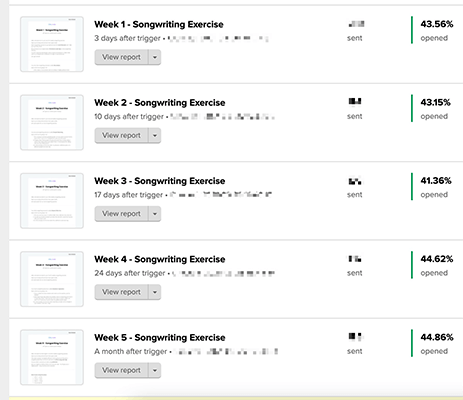
Use it to make an announcement
Your announcement could be about anything – from minor or to of real importance.
Maybe you’ve released a new product, published a new blog post or joined forces with a company?
Here’s an example from Iconfinder:

Announcements are important to your subscribers as they’ll want to know what’s changed or what’s happening, especially if they need to take action.
Ask questions
To improve user engagement try asking questions, especially if you’re highlighting something they potentially want.
This example from Adam here at Blogging Wizard is great because he’s asking a rhetorical question to his readers which will automatically give the response “yes please”:
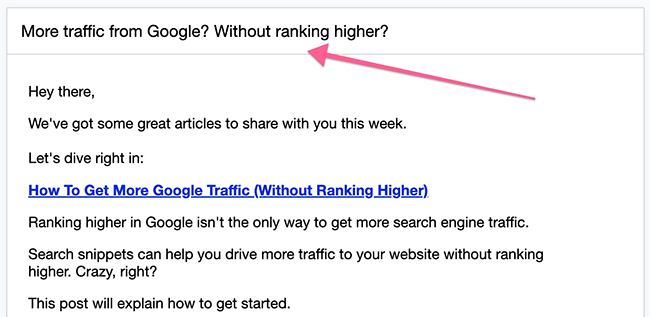
You can achieve this by understanding your audience, especially their pain points. This way you can structure your subject lines and content around something you know they want, this in turn will lead to higher open rates.
Don’t stress about spam words
Nearly every article about subject lines will tell you to avoid spammy words if you want to avoid the spam filter.
However, in his recent podcast appearance for Search Engine Journal, Jay Schwedelson of subjectline.com, a company that has analyzed a multitude of subject lines and what makes them effective said:
You go in the junk folder because you have a bad sending reputation. You have no engagement. The misconception of spam trigger words hurts marketers because they’re trying to write subject lines, not utilizing the words that all marketers know to work the best – things like free or expires.
A/B test
How effective a subject line is can depend on a variety of factors, such as industry, audience, time of day, etc. So make sure to A/B test different elements to optimize them for maximum conversion. But more on this later.
Related Reading: The Top Email Subject Line Statistics You Need To Know.
7. Make it scannable
Very similar rules to writing blog posts apply here. Readers are unlikely to read an entire email.
If a reader is confronted with large blocks of text and it’s an effort to work out what the email is about, they are unlikely to get as far as conversion, so make your email scannable and easy to read.
To make sure the main body text of your email is easily skimmable:
- Use clear headings and subheadings.
- Use bullet points.
- Emphasize important words in bold.
- Avoid lengthy paragraphs.
Here is an awesome example of an email that is easy to read and scan from Nicola Bleu of Your Creative Aura, where she provides an email course on songwriting exercises for musicians.
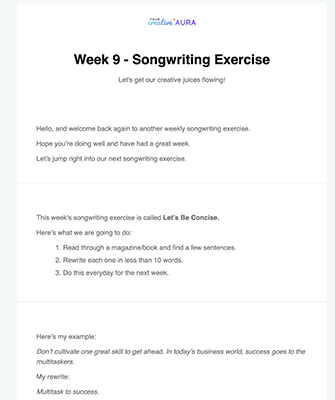
8. Add a stand-out CTA (Call-To-Action)
An email without a CTA (call to action or value) is like a road without a destination.
When it comes to conversions, it is one of the most important factors.
These tips will help you make a clear call to action that converts:
- It stands out on the page.
- You only have one action you want the reader to complete per email.
- Only have one button per email, although you can add more in longer messages.
- Use crystal clear copy: it’s clear to the reader what it is for.
- It’s big enough that it is tappable on mobile devices.
The image may be pushing it with their text to image ratio (see earlier). But Mixmasters are on point with their CTA here. The fact it stands out is undeniable, with its contrasting button color which is also part of their brand palette and white font. It’s big but not too big, and center aligned.
It makes me want to register and I don’t even like House music.

9. Avoid the Spam Filter
100% of emails that aren’t open, don’t convert, and if your emails are getting sent straight to the spam folder, they definitely aren’t getting opened.
Here’s how to avoid the spam filter:
- Use double opt-ins when people join your list.
- Ask recipients to whitelist you when they join your list. The process may be slightly different depending on their email provider.
- Set expectations of what being on your list involves at the start.
- Make unsubscribing easy.
- Keep spam complaints low..
Again Nicola Bleu of Your Creative Aura gives a fantastic example, setting expectations and making it super clear on how to unsubscribe if readers want to:

10. Make your messages responsive
Your emails need to look great and be easy to read on all devices if you want to optimize your conversion rate. If your emails aren’t mobile friendly, then they may not even get read at all. Over 60% of people will delete or ignore emails that don’t work well on mobile phones.
Beatports email is super clear and also visually stunning on mobile in their email about a new Party Mode feature.

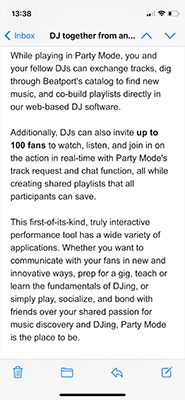
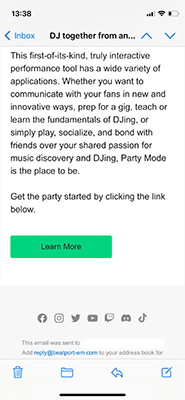
High-quality email marketing software will have responsive email templates with a high conversion centered design, but it’s still best to check that your messages look as good on mobile as the desktop version.
11. Use social proof
Social proof can be a great way to increase conversions through email and landing pages.
It works because people are more likely to trust and invest in you when they see that others have done the same.
Types of social proof you can use include:
- Testimonials from past customers.
- Reviews.
- Ratings.
Here’s another great example from music production coach Mike Monday at Make Music Your Life, showing he’s ahead of the rest of the pack:
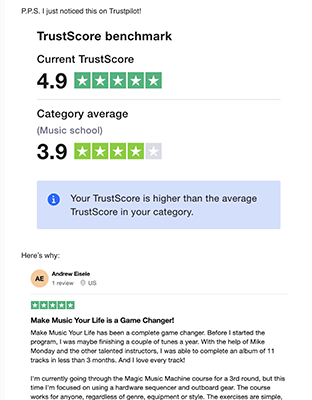
If you want to learn more, check out our article on social proof.
12. Track your email marketing efforts
Designing email campaigns that convert is a fluid process, even though you schedule them to send. If you want to get the best ROI, it is not a set and forget process. Tracking your progress, identifying what is and isn’t working, is all part of creating high-converting emails.
There are a number of important metrics to analyze to ensure the best conversion rate. Engagement is the most popular metric tracked by content marketers. but it is not the only piece of the puzzle and it will depend on the goals of your campaign.
But which metrics should your campaign monitor? Here are the email metrics I’d recommend tracking:
- Open rate
- Click-through rate
- Conversion rate
- Bounce rate
- Total number of unsubscribes
- Forwarding and sharing via email and social media.
13. A/B test your emails
In email marketing, what you think is going to work doesn’t always. What works for one company doesn’t always work for another and sometimes what works on one day doesn’t work the next.
That’s why continual A/B testing is key to optimizing your messages for maximum conversion. A/B testing can improve email conversion by as much as 49%!
A/B testing involves picking one element of your email or campaign and running alternatives at the same time to see which performs better.
It’s especially important for emails where things such as subject lines, and CTAs can be the difference between a customer and just another reader. Again, any email marketing platform mentioned in this article will have quality A/B testing features built in.
You can A/B test:
- Subject Line
- Call to action
- Headline
- Images
- Offer
- Main text
You should also consider testing the time when you send emails. Your data matters most, but use our post on best times to send emails to get started with.
Wrapping it up
So there you have it, 13 powerful tips to design emails with high conversion rates. Start with your audience and work from there to create a tailored strategy.
Once you have a plan, it’s just a matter of jumping through the right hoops to ensure your emails get delivered and opened.
Then seal the deal with personalized, easy-to-read engaging emails that convert leads into customers fast.
Remember to track your progress and A/B test as you go.
Email marketing can yield as much as $36 for every $1 spent. The opportunities are there. You just need to know how to make the most of them.
Disclosure: Our content is reader-supported. If you click on certain links we may make a commission.
